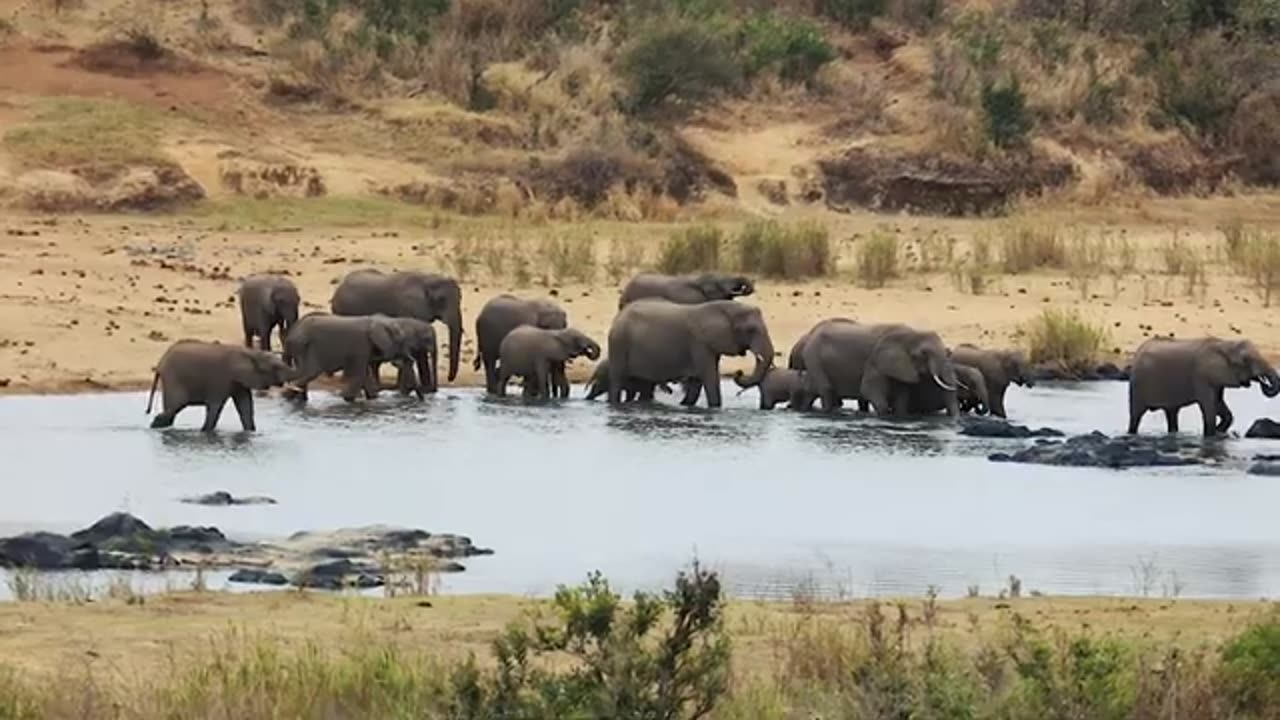Premium Only Content

"Nature's Pathways: Elephants' Epic River Crossings"
1: The Majestic Journey: African Elephants Crossing Rivers
African elephants, the largest land animals on Earth, display remarkable behaviors when they cross rivers, a testament to their strength, intelligence, and intricate social structures. These river crossings are not just a practical necessity but a captivating spectacle of nature, highlighting the resilience and unity of these majestic creatures.
2: Physical Prowess and Adaptations
African elephants are strong swimmers, a skill that is vital for crossing the deep and often treacherous rivers of their habitats. Their buoyant bodies, powered by large, muscular legs, enable them to navigate through strong currents. Utilizing their trunks as snorkels, elephants can breathe while submerged, making even the deepest rivers passable.
3: Social Dynamics in Action
River crossings are a communal effort, typically led by the matriarch, the oldest and most experienced female of the herd. The safety of the youngest members is paramount; adults form protective barriers around the calves, shielding them from swift currents and potential predators such as crocodiles. Communication through vocalizations and body language is crucial, ensuring the herd remains coordinated and cohesive.
4: Motivations for Crossing
Elephants cross rivers primarily for survival. Seasonal migrations in search of food and water often necessitate these crossings, especially during dry spells. Additionally, elephants may seek out new foraging grounds or engage in social activities that reinforce the bonds within the herd.
5: Challenges and Risks
The journey across a river is fraught with challenges. Strong currents and deep waters can be perilous, particularly for younger or weaker individuals. Predators like crocodiles pose significant threats, and human activities, such as dam construction and pollution, further complicate these crossings. These obstacles underscore the importance of conservation efforts aimed at preserving natural habitats and ensuring safe passage for elephants.
6: Observations and Conservation Efforts
Scientists and conservationists closely monitor elephant river crossings to gain insights into their migratory patterns, social behaviors, and habitat requirements. Protecting these majestic animals involves creating wildlife corridors, mitigating human-elephant conflicts, and maintaining the health of river ecosystems. Notable crossings, such as those of the Zambezi and Chobe rivers, are critical points in the elephants' migratory routes and serve as focal areas for conservation initiatives.
7: A Symbol of Resilience
The sight of African elephants crossing rivers is a powerful symbol of resilience and unity in the animal kingdom. These crossings highlight the complex interplay of physical strength, social bonds, and environmental challenges that define the lives of these magnificent creatures. By understanding and supporting their needs, we can help ensure that future generations continue to witness this awe-inspiring natural phenomenon.
-
 10:25
10:25
MattMorseTV
6 hours ago $4.46 earnedVance just DROPPED a NUKE.
6.58K23 -
 LIVE
LIVE
Jokeuhl Gaming and Chat
4 hours agoDARKTIDE - Warhammer 40k w/ Nubes and AoA
61 watching -
 LIVE
LIVE
Shoriantrax
32 minutes agoLIVE: Hardcore Chaos in Tarkov – Loot, Die, Repeat!
12 watching -
 LIVE
LIVE
John_Goetz
1 hour agoJohn Gets Gaming - Medal of Honor Vanguard Part 2
31 watching -
 1:29:09
1:29:09
RiftTV
2 hours agoSydney Sweeney Spreading RACIST Propaganda? | The Rift | Guest: Braeden Sorbo + Sarah Stock
23.8K6 -
 LIVE
LIVE
VapinGamers
1 hour ago $0.01 earnedDestiny 2 - The Premium Destiny 2 Experience with the Community! - !rumbot !music
11 watching -
 UPCOMING
UPCOMING
We Like Shooting
14 hours agoWe Like Shooting 621 (Gun Podcast)
168 -
 LIVE
LIVE
PudgeTV
6 hours ago🔵 Mod Mondays Ep 69 | Grimm Hollywood - The 3k on Mod Mondays
94 watching -
 LIVE
LIVE
megimu32
2 hours agoOTS: Happy Place or Missed Shot? Happy Gilmore 2 Review
126 watching -
 7:53:48
7:53:48
Dr Disrespect
10 hours ago🔴LIVE - DR DISRESPECT - WARZONE - RAGE ON THE MAIN STAGE
170K21